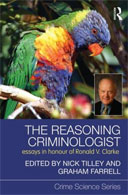The Reasoning Criminologist: Essays in Honour of Ronald V. Clarke

Author: Nick Tilley and Graham Farrell (editors)
Publisher: London; New York: Routledge, 2012. 288p.
Reviewer: Jackson Toby | March 2012
For decades criminologists pursued a fruitless approach to the problem of reducing criminality. They tried to discover why people commit crimes and, to the extent that they uncovered the motivations of those who did so, how to persuade them to stop.
Ronald Clarke recognized that this was a blind alley. Offenders offend for too many different reasons. And once perpetrators obtain satisfaction from whatever criminal acts they engage in, getting them to prefer law-abiding behavior is extraordinarily difficult. Clarke’s insight was a brilliant simplification of the problem: forget the offender and focus on preventing the offense. How? By manipulating the situation in which the potential offender decides to offend. “Situational crime prevention” – the name he gave to a rational-choice approach – assumes that whatever the motivation of the potential offender, he or she is at least partially reasonable. If society creates a situation where attempting a particular crime in a particular place will probably result in failure or capture, the potential offender usually decides against attempting it.
This insight was recognized by many of Clarke’s colleagues and students as yielding better clues to crime prevention than, for example, the life histories criminologists traditionally collected. Edwin Sutherland, a founding father of criminology, published a biography of an imprisoned professional thief, and Clifford Shaw, another founding father, published a number of biographical accounts of predatory male young adults from low-income neighborhoods in Chicago. And Donald Cressey conducted a study of embezzlers. Sutherland, Shaw, and Cressey probably believed that their biographies of offenders threw light on the causes of criminality. Not clear was how their biographies of criminals would help to prevent crime. Nevertheless, the life-history tradition seemed to hold more appeal to criminologists than Ronald Clarke’s more rigorous, more scientific approach.
As far as I know, Clarke did not make a frontal attack on the obvious deficiencies of traditional criminology at showing how to prevent crime. He did not even suggest to his students – mischievously, because Ronald Clarke has a mischievous personality — that, if they liked, he could arrange for them to attend office hours given by prisoners at the Trenton State Prison to explain to them about the causes of crime. After all, prisoners had been committing crimes repeatedly. Traditional criminologists might believe that prisoners can throw more light on the causes of and remedies for crime than a law-abiding college professor like Clarke who hasn’t even been arrested. If some had taken up his offer and gone to talk with prisoners, what would they have learned? Clarke would surely have told them that they could only have gotten accounts of deviant motives, not anything about why they failed to control these motives. He might have added, although too gentlemanly to do so, that most criminologists continue to follow the example of Sutherland, Shaw, and Cressey in lemming-like imitation of a relatively useless approach instead of the more fruitful approach that he invented: situational crime prevention. Criminologists are a stubborn lot. They have not totally ignored Ronald Clarke, but neither have they refocused their research attention as much as they should have on situational crime prevention.
Consequently, this volume serves two purposes. For one, it is a deserved tribute to Ronald Clarke and his ground-breaking revision of the criminological understanding of crime prevention. In the first two introductory chapters, Pat Mayhew, Mike Hough, Derek Cornish, and Martha Smith tell the reader about Ron Clarke’s personal and professional history, thus explaining how he gradually developed the intellectual framework of situational crime prevention. In Chapter 17, Graeme Newman and Joshua Freilich show how this intellectual framework expanded to include more preventive possibilities than Clarke originally anticipated. The second purpose of the festschrift takes up most of the space of the book; it is a compendium of research stimulated by Clarke’s revisionist thinking. I turn now to a discussion of these research spinoffs. I will call attention to elements of situational crime prevention that particular authors mentioned, but many of the contributors mentioned several elements. It is an oversimplification to imply that a contributor only discussed one type of situational crime prevention.
In Chapter 11, David Weisburd and Cody Telep point to the issue of the possible displacement of crime and the related question of the diffusion of the benefits of situational crime prevention. That is to say, they show empirically not only that smarter police efforts can reduce crime in targeted areas but that the crime prevented does not just move around the corner and spring up someplace else. They also suggest the reason for this: most crime is tied to its location in space and cannot readily be transferred to another location. In the musical, “Guys and Dolls,” Nathan Detroit is the proprietor of the “oldest established permanent crap game in New York,” moving from one location to another – including a Salvation Army mission. That was wonderful theater but not very good criminology, as Weisburd and Cody show, because crime tends to be concentrated at certain sites. Bowers and Johnson added another wrinkle. They showed that situational crime prevention measures can reduce crime in a targeted area, but they have a greater deterrent impact on opportunistic potential offenders than on chronic offenders.
Paul Ekblom pointed out in Chapter 4 the convergence of the situational crime prevention tradition with the ideas of defensible space, that is, of architectural design that reduces temptations to commit crimes or opportunities to do so. If these ideas had been better understood, many high-rise public housing projects in American cities would never have been built – and later, because they were built, dynamited down because they had become so dangerous that few low-income families wanted to live in them, e.g. the Pruitt Igoe public housing project in St. Louis, Missouri.
Anthony Braga and David Kennedy point out in Chapter 5 on “focused deterrence” that situational crime prevention can have more powerful effects if it focuses on a specific crime problem rather than on crime generally in a neighborhood or on a variety of crimes. As an example of the fruitfulness of this approach, they cite the Boston police effort to reduce gang violence in Operation Cease Fire, a spinoff of the Boston Gun Project. The police reached out to youth gangs and communicated the message that, although some crime would be ignored, there would be strong, swift responses to violent crimes, such asrevoking probation of youngsters in the gang who commit violent crimes and setting high bail for them to keep them in jail.
John Eck, Tamara Madensen, Michael Scott, Johannes Knutsson, and Herman Goldstein showed how problem-oriented policing could reinforce the attractiveness and effectiveness of situational crime prevention. Problem-oriented policing, the brainchild of Herman Goldstein, was popular with police officials as well as with lower-rank police officers because problem-oriented policing clearly explained that the effectiveness of police work had to be judged by the specific tasks police are asked to handle. If the public was concerned only with keeping children safe from speeding cars in the neighborhood, police should be evaluated by their success in preventing drag races and other speeding offenses, not by the burglary rates of their communities. In Chapter 7, Goldstein and his colleague, Michael Scott, show how problem oriented policing and situational crime prevention, working in conjunction, mutually reinforce one another and therefore accomplish more in the way of crime prevention than might be expected from their additive effect. “…[Clarke] helped police to understand not only that their efforts might not displace crime, but also that they might have crime prevention benefits beyond what was anticipated.” [p. 101]
In Chapter 9, Mike Maxfield emphasized the importance of specificity in making evidence-based evaluations feasible — and gives Ron Clarke credit for developing this necessary condition in situational crime prevention. In Chapter 10, Nancy LaVigne describes studies of the deployment of surveillance cameras in three cities, Baltimore, Chicago, and Washington, D.C. to prevent crime. She demonstrates that camera surveillance is more effective at preventing crimes of various specific kinds, depending on how the cameras are deployed and monitored. It was most successful in Baltimore, probably because Baltimore conformed best to the theoretically derived requirements of situational crime prevention.
In Chapter 12, David Lester shows that Ronald Clarke’s insight about the impact of the situation on behavior applies not only to crime prevention but to preventing other kinds of behavior that society has an interest in; Clarke demonstrated how the English suicide rate was reduced by changing the composition of household cooking gas. In Chapter 13, Ken Pease and Gloria Laycock continue the process of showing the wide range of situational determinants of behavior that Clarke worked on or inspired, including the image of the picture of a fly in the urinals of the Schiphol Airport and thereby helped keep users careful. In Chapter 16, Marcus Felson extends the relevance of situational crime prevention to expressive violence, usually considered irrational and therefore not subject to the instrumental calculations that potential offenders make. In Chapter 15, Mangai Natarajan used situational crime prevention to throw light on illegal international smuggling by organized crime. And in Chapter 14, Richard Wortley returns to the criminal’s contribution to crime by showing that combining characteristics of the potential offender with characteristics of the situation increases the accuracy of predictions of prevention.
Finally, in Chapter 19, the last chapter in the book, Paul and Patricia Brantingham address the issue of the political palatability of situational crime prevention programs. Their verdict is that most situational crime prevention programs pass with flying colors. One reason they are palatable is they do not have to operate for decades to show results. Consequently they are not at the mercy of new leaders who come into power at the next election.
Unlike most festschrifts that are held together only by the binding of the book because the contributions represent the disparate intellectual interests of the contributors, this one has intellectual coherence. Its unity is provided by contributors who wish to pay tribute to Ronald Clarke by illustrating and extending his ground-breaking insight into preventing crime through situational crime prevention. It is a deserved tribute that he will cherish.
Jackson Toby is professor of sociology emeritus at Rutgers University where he was director of the Institute for Criminological Research.


